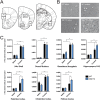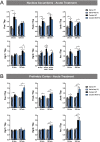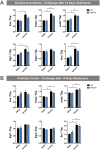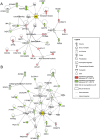Blockade of the 5-HT transporter contributes to the behavioural, neuronal and molecular effects of cocaine
- PMID: 28585320
- PMCID: PMC5522997
- DOI: 10.1111/bph.13899
Blockade of the 5-HT transporter contributes to the behavioural, neuronal and molecular effects of cocaine
Abstract
Background and purpose: The psychostimulant cocaine induces complex molecular, cellular and behavioural responses as a consequence of inhibiting presynaptic dopamine, noradrenaline and 5-HT transporters. To elucidate 5-HT transporter (SERT)-specific contributions to cocaine action, we evaluated cocaine effects in the SERT Met172 knock-in mouse, which expresses a SERT coding substitution that eliminates high-affinity cocaine recognition.
Experimental approach: We measured the effects of SERT Met172 on cocaine antagonism of 5-HT re-uptake using ex vivo synaptosome preparations and in vivo microdialysis. We assessed SERT dependence of cocaine actions behaviourally through acute and chronic locomotor activation, sensitization, conditioned place preference (CPP) and oral cocaine consumption. We used c-Fos, quantitative RT-PCR and RNA sequencing methods for insights into cellular and molecular networks supporting SERT-dependent cocaine actions.
Key results: SERT Met172 mice demonstrated functional insensitivity for cocaine at SERT. Although they displayed wild-type levels of acute cocaine-induced hyperactivity or chronic sensitization, the pattern of acute motor activation was different, with a bias toward thigmotaxis. CPP was increased, and a time-dependent elevation in oral cocaine consumption was observed. SERT Met172 mice displayed relatively higher levels of neuronal activation in the hippocampus, piriform cortex and prelimbic cortex (PrL), accompanied by region-dependent changes in immediate early gene expression. Distinct SERT-dependent gene expression networks triggered by acute and chronic cocaine administration were identified, including PrL Akt and nucleus accumbens ERK1/2 signalling.
Conclusion and implications: Our studies reveal distinct SERT contributions to cocaine action, reinforcing the possibility of targeting specific aspects of cocaine addiction by modulation of 5-HT signalling.
© 2017 The British Pharmacological Society.
Figures









Similar articles
-
Cocaine modulates mammalian circadian clock timing by decreasing serotonin transport in the SCN.Neuroscience. 2014 Sep 5;275:184-93. doi: 10.1016/j.neuroscience.2014.06.012. Epub 2014 Jun 17. Neuroscience. 2014. PMID: 24950119 Free PMC article.
-
Regional differences in extracellular dopamine and serotonin assessed by in vivo microdialysis in mice lacking dopamine and/or serotonin transporters.Neuropsychopharmacology. 2004 Oct;29(10):1790-9. doi: 10.1038/sj.npp.1300476. Neuropsychopharmacology. 2004. PMID: 15226739
-
The SERT Met172 Mouse: An Engineered Model To Elucidate the Contributions of Serotonin Signaling to Cocaine Action.ACS Chem Neurosci. 2019 Jul 17;10(7):3053-3060. doi: 10.1021/acschemneuro.9b00005. Epub 2019 Mar 13. ACS Chem Neurosci. 2019. PMID: 30817127 Review.
-
Essential Contributions of Serotonin Transporter Inhibition to the Acute and Chronic Actions of Fluoxetine and Citalopram in the SERT Met172 Mouse.Neuropsychopharmacology. 2016 Jun;41(7):1733-41. doi: 10.1038/npp.2015.335. Epub 2015 Oct 30. Neuropsychopharmacology. 2016. PMID: 26514584 Free PMC article.
-
A pharmacological analysis of mice with a targeted disruption of the serotonin transporter.Psychopharmacology (Berl). 2007 Dec;195(2):147-66. doi: 10.1007/s00213-007-0910-0. Epub 2007 Aug 22. Psychopharmacology (Berl). 2007. PMID: 17712549 Review.
Cited by
-
Kappa Opioid Receptor Mediated Differential Regulation of Serotonin and Dopamine Transporters in Mood and Substance Use Disorder.Handb Exp Pharmacol. 2022;271:97-112. doi: 10.1007/164_2021_499. Handb Exp Pharmacol. 2022. PMID: 34136961 Review.
-
Network preservation reveals shared and unique biological processes associated with chronic alcohol abuse in NAc and PFC.PLoS One. 2020 Dec 17;15(12):e0243857. doi: 10.1371/journal.pone.0243857. eCollection 2020. PLoS One. 2020. PMID: 33332381 Free PMC article.
-
Rapid Synthesis of Psychoplastogenic Tropane Alkaloids.JACS Au. 2023 Oct 5;3(10):2703-2708. doi: 10.1021/jacsau.3c00472. eCollection 2023 Oct 23. JACS Au. 2023. PMID: 37885569 Free PMC article.
-
Innate cocaine-seeking vulnerability arising from loss of serotonin-mediated aversive effects of cocaine in rats.Cell Rep. 2023 May 30;42(5):112404. doi: 10.1016/j.celrep.2023.112404. Epub 2023 Apr 20. Cell Rep. 2023. PMID: 37083325 Free PMC article.
-
Differential genetic expression within reward-specific ensembles in mice.bioRxiv [Preprint]. 2024 Feb 8:2023.11.02.565378. doi: 10.1101/2023.11.02.565378. bioRxiv. 2024. PMID: 37961222 Free PMC article. Preprint.
References
MeSH terms
Substances
Grants and funding
LinkOut - more resources
Full Text Sources
Other Literature Sources
Medical
Miscellaneous

